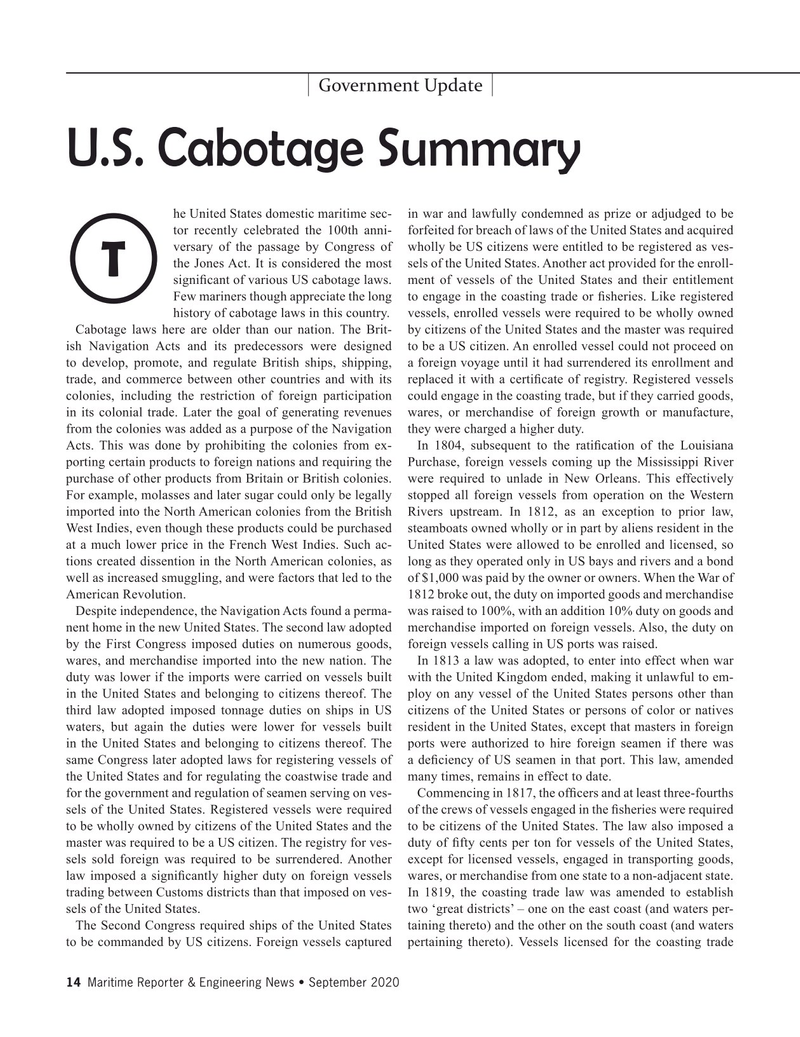
Page 14: of Maritime Reporter Magazine (September 2020)
Marine Design Annual
Read this page in Pdf, Flash or Html5 edition of September 2020 Maritime Reporter Magazine
Government Update
U.S. Cabotage Summary he United States domestic maritime sec- in war and lawfully condemned as prize or adjudged to be tor recently celebrated the 100th anni- forfeited for breach of laws of the United States and acquired versary of the passage by Congress of wholly be US citizens were entitled to be registered as ves- the Jones Act. It is considered the most sels of the United States. Another act provided for the enroll-
T signi? cant of various US cabotage laws. ment of vessels of the United States and their entitlement
Few mariners though appreciate the long to engage in the coasting trade or ? sheries. Like registered history of cabotage laws in this country. vessels, enrolled vessels were required to be wholly owned
Cabotage laws here are older than our nation. The Brit- by citizens of the United States and the master was required ish Navigation Acts and its predecessors were designed to be a US citizen. An enrolled vessel could not proceed on to develop, promote, and regulate British ships, shipping, a foreign voyage until it had surrendered its enrollment and trade, and commerce between other countries and with its replaced it with a certi? cate of registry. Registered vessels colonies, including the restriction of foreign participation could engage in the coasting trade, but if they carried goods, in its colonial trade. Later the goal of generating revenues wares, or merchandise of foreign growth or manufacture, from the colonies was added as a purpose of the Navigation they were charged a higher duty.
Acts. This was done by prohibiting the colonies from ex- In 1804, subsequent to the rati? cation of the Louisiana porting certain products to foreign nations and requiring the Purchase, foreign vessels coming up the Mississippi River purchase of other products from Britain or British colonies. were required to unlade in New Orleans. This effectively
For example, molasses and later sugar could only be legally stopped all foreign vessels from operation on the Western imported into the North American colonies from the British Rivers upstream. In 1812, as an exception to prior law,
West Indies, even though these products could be purchased steamboats owned wholly or in part by aliens resident in the at a much lower price in the French West Indies. Such ac- United States were allowed to be enrolled and licensed, so tions created dissention in the North American colonies, as long as they operated only in US bays and rivers and a bond well as increased smuggling, and were factors that led to the of $1,000 was paid by the owner or owners. When the War of
American Revolution. 1812 broke out, the duty on imported goods and merchandise
Despite independence, the Navigation Acts found a perma- was raised to 100%, with an addition 10% duty on goods and nent home in the new United States. The second law adopted merchandise imported on foreign vessels. Also, the duty on by the First Congress imposed duties on numerous goods, foreign vessels calling in US ports was raised. wares, and merchandise imported into the new nation. The In 1813 a law was adopted, to enter into effect when war duty was lower if the imports were carried on vessels built with the United Kingdom ended, making it unlawful to em- in the United States and belonging to citizens thereof. The ploy on any vessel of the United States persons other than third law adopted imposed tonnage duties on ships in US citizens of the United States or persons of color or natives waters, but again the duties were lower for vessels built resident in the United States, except that masters in foreign in the United States and belonging to citizens thereof. The ports were authorized to hire foreign seamen if there was same Congress later adopted laws for registering vessels of a de? ciency of US seamen in that port. This law, amended the United States and for regulating the coastwise trade and many times, remains in effect to date. for the government and regulation of seamen serving on ves- Commencing in 1817, the of? cers and at least three-fourths sels of the United States. Registered vessels were required of the crews of vessels engaged in the ? sheries were required to be wholly owned by citizens of the United States and the to be citizens of the United States. The law also imposed a master was required to be a US citizen. The registry for ves- duty of ? fty cents per ton for vessels of the United States, sels sold foreign was required to be surrendered. Another except for licensed vessels, engaged in transporting goods, law imposed a signi? cantly higher duty on foreign vessels wares, or merchandise from one state to a non-adjacent state. trading between Customs districts than that imposed on ves- In 1819, the coasting trade law was amended to establish sels of the United States. two ‘great districts’ – one on the east coast (and waters per-
The Second Congress required ships of the United States taining thereto) and the other on the south coast (and waters to be commanded by US citizens. Foreign vessels captured pertaining thereto). Vessels licensed for the coasting trade 14 Maritime Reporter & Engineering News • September 2020
MR #9 (1-17).indd 14 9/9/2020 7:43:07 AM

 13
13

 15
15
